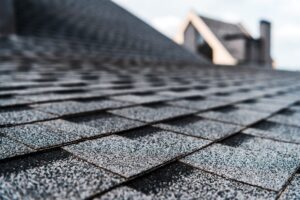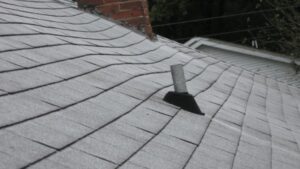When to Replace Your Asphalt Shingles: Signs to Look For
Asphalt shingles are one of the most popular roofing materials due to their affordability, ease of installation, and durability. However, like all roofing materials, they don’t last forever. Over time, exposure to the elements can cause wear and tear, and understanding when it’s time to replace your asphalt shingles is essential to protecting your home. This blog post will explore the common signs that indicate your asphalt shingles may need replacing and why timely replacement can save you from costly repairs in the future.
Age of Your Asphalt Shingles
 One of the first indicators that it might be time to replace your asphalt shingles is their age. While asphalt shingles generally last around 20 to 25 years, this can vary depending on factors such as climate, installation quality, and maintenance. If your shingles are approaching the end of their expected lifespan, it’s a good idea to have them inspected. A professional roofer can evaluate their condition and help you determine whether a replacement is necessary.
One of the first indicators that it might be time to replace your asphalt shingles is their age. While asphalt shingles generally last around 20 to 25 years, this can vary depending on factors such as climate, installation quality, and maintenance. If your shingles are approaching the end of their expected lifespan, it’s a good idea to have them inspected. A professional roofer can evaluate their condition and help you determine whether a replacement is necessary.
As shingles age, they can begin to lose their granules, resulting in a thinner layer of protection. This can make your roof more vulnerable to water damage, leaks, and heat penetration. If your roof is nearing the 20-year mark, it’s worth considering a replacement to avoid unexpected problems.
Curling or Buckling Shingles
Shingles that are curling or buckling are a clear sign that your roof is under stress and may need replacement. This type of damage typically occurs due to prolonged exposure to the sun, wind, or extreme weather conditions. Curling occurs when the edges of the shingles turn upwards, while buckling refers to shingles that have developed a wave-like pattern.
If you notice any shingles curling or buckling, it’s essential to address the problem immediately. These conditions leave your roof susceptible to leaks and water damage, as the protective barrier is compromised. While a few curled shingles may be repaired, widespread curling or buckling often requires a full replacement.
Missing Shingles
If you notice that your roof is missing shingles, it’s a clear indication that your asphalt shingles may no longer be performing their best. While a few missing shingles can often be replaced, large patches of missing shingles can signal that the overall roof is deteriorating. Missing shingles leave your roof exposed to water, which can cause structural damage over time.
Strong winds or severe storms can blow shingles off, especially if they are already loose or damaged. If your roof is missing a significant number of shingles, it’s time to consult with a roofing professional to assess the condition of your roof and determine whether it’s time for a replacement.
Granule Loss
Asphalt shingles are coated with granules that protect them from UV rays and give them their color. Over time, these granules can wear off, leading to bald spots on your shingles. Granule loss is a natural process, but if you notice significant areas of baldness on your shingles, it can reduce the effectiveness of your roof’s protection against the elements.
You may also notice a buildup of granules in your gutters, which is a sign that they are coming off your shingles. If this issue is widespread, it’s time to consider replacing the shingles to prevent further deterioration and protect your home from leaks and water damage.
Roof Leaks
Water stains on your ceilings or walls, particularly in the attic, are a clear sign of a leak in your roof. Leaks can occur for many reasons, but one of the most common causes is damaged or deteriorating asphalt shingles. If the shingles have cracked, split, or curled, they are unable to provide a watertight seal, allowing water to seep into your home.
A roof leak can cause significant damage to your home if not addressed quickly. If you notice signs of water damage or experience leaks during rainy weather, it’s time to have your roof inspected. A professional roofer will be able to identify the source of the leak and recommend whether a full roof replacement is necessary.
Algae or Moss Growth
 Algae and moss can grow on your roof if it’s consistently damp or shaded. While this is often seen as a cosmetic issue, it can also signal underlying damage. Algae and moss can trap moisture against your shingles, which can lead to premature deterioration.
Algae and moss can grow on your roof if it’s consistently damp or shaded. While this is often seen as a cosmetic issue, it can also signal underlying damage. Algae and moss can trap moisture against your shingles, which can lead to premature deterioration.
In addition, moss can lift and separate shingles, allowing water to penetrate and cause leaks. If you notice algae or moss growing on your roof, it’s essential to remove it promptly and inspect the shingles for damage. In some cases, cleaning the roof may be enough to restore its appearance and functionality, but if the growth has caused significant damage, a replacement may be required.
Sagging Roof
A sagging roof is a serious problem that requires immediate attention. If you notice that your roof appears to be sagging or dipping in certain areas, it could indicate structural damage caused by water infiltration, aging materials, or improper installation. Sagging can also be a result of heavy snow accumulation or a buildup of debris on the roof.
If your roof is sagging, it’s crucial to have it inspected by a professional immediately. A sagging roof may need more than just a shingle replacement; it could indicate that the roof deck or other structural components are compromised, and a full roof replacement may be necessary.